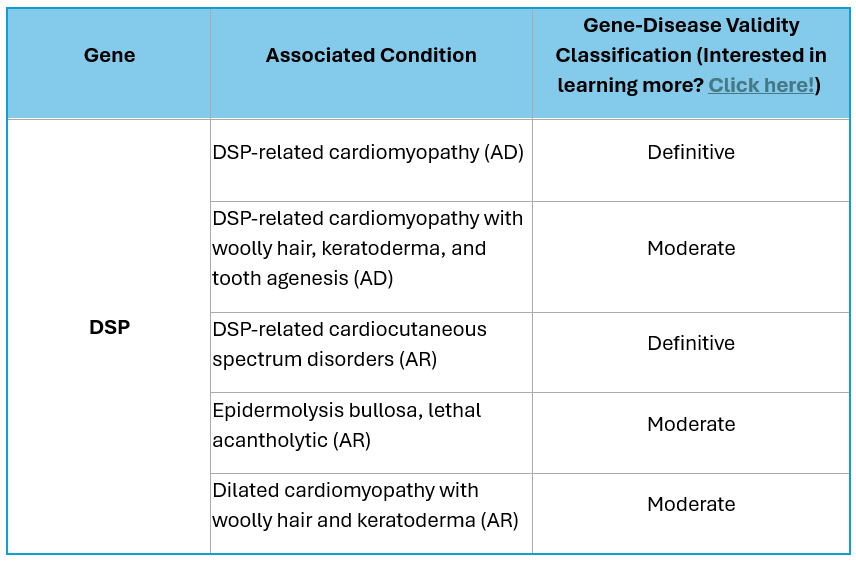
Welcome to the Gene Scene! Each week, we will explore a gene from the ACMG Secondary Findings list—genes identified by the American College of Medical Genetics and Genomics as having clear, actionable health implications.These genes are included because they’re linked to serious but preventable or manageable conditions when identified early. Here, we focus on the condition that led to the gene’s inclusion on the list, providing clear, relevant information that supports your clinic. To subscribe to the Gene Scene, contact your local GSL or send a request to info@ambrygen.com.
To access the Gene Scene archives, visit our blog.
Clinical Phenotype Summary:
The DSP gene (NM_004415.2), which contains 24 coding exons and is located on chromosome 6p24.3, encodes the desmoplakin protein. Pathogenic variants in this gene are known to cause DSP-related cardiomyopathy and DSP-related cardiomyopathy with woolly hair, keratoderma, and tooth agenesis (DCWHKTA), which are inherited in an autosomal dominant fashion, and a spectrum of DSP-related cardiocutaneous disorders, including dilated cardiomyopathy with woolly hair and keratoderma (DCWHK; also known as Carvajal syndrome), skin fragility-woolly hair syndrome (SFWHS), and lethal acantholytic epidermolysis bullosa (LAEB), which are inherited in an autosomal recessive fashion.
DSP-related cardiomyopathy is a distinct form of arrhythmogenic cardiomyopathy characterized by:
- Episodic myocardial inflammation
- Predominantly left ventricular fibrosis that precedes left ventricular systolic dysfunction
- Ventricular arrhythmias
DSP-related cardiocutaneous disorders, including dilated cardiomyopathy with woolly hair and keratoderma (DCWHK; also known as Carvajal syndrome), skin fragility-woolly hair syndrome (SFWHS), and lethal acantholytic epidermolysis bullosa (LAEB), are characterized by:
- Features may include skin, hair, nail, and/or cardiac anomalies with varying degrees of severity
- Possible neonatal onset
DSP-related cardiomyopathy with woolly hair, keratoderma, and tooth agenesis (DCWHKTA) is characterized by:
- Cardiomyopathy
- Palmoplantar keratoderma
- Wooly or sparse hair
- Dental abnormalities
Unique Considerations:
Reduced penetrance and highly variable expressivity are reported with DSP variants. Loss of function has been reported as the mechanism of disease for DSP-related cardiomyopathy and DCWHKTA. Biallelic loss of function has been reported as the mechanism of disease for DSP-related cardiocutaneous spectrum disorders.
Clinical Resources:
Understanding your Secondary Findings Result
Clinician Management Resources and Understanding Your Results for Positive Cardiovascular Results
Ambry Knows Genes:
Scientific Presentations:
The Power of Cardiovascular Genetic Testing: From Implementation to Targeted Therapies (Educate Next 2024)
Variant reclassification in a large cardiogenetic testing cohort: The importance of disease-specific variant classification criteria (ACMG 2023)
Scientific Posters:
More than 95% of positive genetic results for inherited cardiomyopathies and arrhythmias have medical management implications (NSGC 2021)
Preventing Sudden Cardiac Death(?): Exome Secondary Findings in Cardiovascular Genes (NSGC 2017)
Citations:
Campuzano O, et al. J Med Genet. 2013 May;50(5):280-9; PMID:23468208
Castelletti S, et al. Int J Cardiol. 2017 Dec 15;249:268-273; PMID:28527814
Smith ED, et al. Circulation . 2020 Jun 9;141(23):1872-1884) PMID:32372669
Chalabreysse L et al, J Dent Res. 2011 Jan;90(1):58-64.; PMID:20940358
Boule S, et al. Int J Cardiol. 2012 Nov 1;161(1):50-2.; PMID:22795705
Boyden LM, et al. Hum Mol Genet. 2016 Jan 15;25(2):348-57). PMID:26604139
Norgett EE et al, Hum Mol Genet. 2000 Nov 1;9(18):2761-6; PMID:11063735
Whittock NV, et al. J Invest Dermatol. 2002 Feb;118(2):232-8; PMID:11841538
Jonkman MF, et al. Am J Hum Genet. 2005 Oct;77(4):653-60; PMID:16175511
Bolling MC, et al. Br J Dermatol. 2010 Jun;162(6):1388-94). PMID:20302578
Ambry Genetics Gene-Disease Validity Scheme
To learn more about the ACMG Secondary Findings list, click here.
To read all previous Gene Scene emails, click here.




